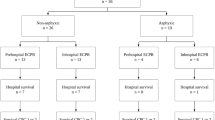Abstract
A 43-year-old woman became exhausted and fainted on descent at 1127 MAMSL altitude and snowfall. A rescue team diagnosed asystole. With manual cardiopulmonary resuscitation (CPR) she was transported to the next extracorporeal life support (ECLS) center. Admission temperature was 20.7 °C. CPR continued until ECLS was initiated. Two days later she was awake, orientated, and with no neurological deficits. With hypothermic cardiac arrest, a favorable outcome depends on early continuous CPR, triage, and ECLS rewarming. It holds true that “nobody is dead until they are warmed and dead” if one cools first and arrests thereafter.
Zusammenfassung
Eine 43-jährige Frau erschöpfte sich beim Abstieg auf 1127 m und gleichzeitigem Schneefall. Die Rettungskräfte fanden sie mit einer Asystolie vor. Unter laufender manueller kardiopulmonaler Wiederbelebung („cardiopulmonary resuscitation“, CPR) wurde sie mit dem Helikopter ins nächste Zentrum mit extrakorporaler Wiedererwärmung („extracorporeal life support“, ECLS) transportiert. Die Körperkerntemperatur bei Aufnahme betrug 20,7 °C. Zwei Tage später war sie wach, orientiert und ohne neurologisches Defizit. Frühestmögliche kontinuierliche CPR, Triage und ECLS sind bei durch Hypothermie bedingtem Herzstillstand entscheidend. Dieser Fall bestätigt dass „Niemand tot ist, bis er nicht warm und tot ist“, vorausgesetzt die tiefe Hypothermie tritt vor dem Herzstillstand ein.
Similar content being viewed by others
References
Schober A, Sterz F, Handler C et al (2014) Cardiac arrest due to accidental hypothermia – a 20 year review of a rare condition in an urban area. Resuscitation 85:749–756
Walpoth BH, Walpoth-Aslan BN, Mattle HP et al (1997) Outcome of survivors of accidental deep hypothermia and circulatory arrest treated with extracorporeal blood warming. N Engl J Med 337:1500–1505
Hilmo J, Naesheim T, Gilbert M (2014) “Nobody is dead until warm and dead”: prolonged resuscitation is warranted in arrested hypothermic victims also in remote areas – a retrospective study from northern Norway. Resuscitation 85:1204–1211
Gilbert M, Busund R, Skagseth A, Nilsen PA, Solbo JP (2000) Resuscitation from accidental hypothermia of 13.7 degrees C with circulatory arrest. Lancet 355:375–376
Althaus U, Aeberhard P, Schupbach P, Nachbur BH, Muhlemann W (1982) Management of profound accidental hypothermia with cardiorespiratory arrest. Ann Surg 195:492–495
Truhlar A, Deakin CD, Soar J et al (2015) European Resuscitation Council Guidelines for Resuscitation 2015: Section 4. Cardiac arrest in special circumstances. Resuscitation 95:148–201
Putzer G, Braun P, Zimmermann A, Pedross F, Strapazzon G, Brugger H, Paal P (2013) LUCAS compared to manual cardiopulmonary resuscitation is more effective during helicopter rescue – a prospective, randomized, cross-over manikin study. Am J Emerg Med 31(2):384–389
Brown DJ, Brugger H, Boyd J, Paal P (2012) Accidental hypothermia. N Engl J Med 367:1930–1938
Gordon L, Paal P, Ellerton JA, Brugger H, Peek GJ, Zafren K (2015) Delayed and intermittent CPR for severe accidental hypothermia. Resuscitation 90:46–49
Boue Y, Payen JF, Brun J et al (2014) Survival after avalanche-induced cardiac arrest. Resuscitation 85:1192–1196
Paal P, Gordon L, Strapazzon G et al (2016) Accidental hypothermia – an update. Scand J Trauma Resusc Emerg Med 24(1):111. doi:10.1186/s13049-016-0303-7
Author information
Authors and Affiliations
Corresponding author
Ethics declarations
Conflict of interest
I. Eckert, P. Imboden, P. Paal, and J. Koppenberg declare that they have no competing interests.
This article does not contain any studies with human participants or animals performed by any of the authors. Consent was obtained from all patients identifiable from images or other information within the manuscript. In the case of underage patients, consent was obtained from a parent or legal guardian.
Additional information
An erratum to this article is available at http://dx.doi.org/10.1007/s00101-017-0292-6.
Rights and permissions
About this article
Cite this article
Eckert, I., Imboden, P., Paal, P. et al. Good neurological outcome after accidental hyopthermia presenting with asytole. Anaesthesist 66, 186–188 (2017). https://doi.org/10.1007/s00101-017-0271-y
Received:
Revised:
Accepted:
Published:
Issue Date:
DOI: https://doi.org/10.1007/s00101-017-0271-y




